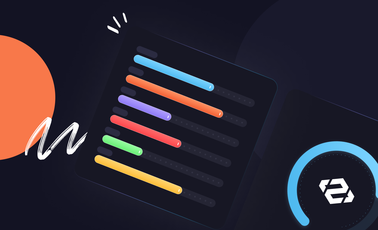Looking into the Crystal Ball: Our 2022 Predictions
We started our blog on May 1, 2021, and published 60 blog posts in the last eight months of the year. While our primary focus was the developments in the low-code/no-code segment, we have had some recurring topics in our posts, like the digital transformation and the drastic changes taking place in the labor market. As we begin a new year, we thought it would be a good idea to gather a collection of predictions on these topics and try to see what 2022 has in store for us.
1 - Digital transformation
The phrase "digital transformation" came to define the last two years in the business world. Every company, big or small, tried to take a step in the right direction and digitize its processes. Businesses around the globe spent $1.31 trillion on digital transformation in 2020, and $1.5 trillion in 2021. This trend will likely continue in 2022, with a 20 percent increase over the 2021 figure. According to a survey Techrepublic conducted among 110 SMB decision-makers, 69 percent of the respondents said that their digital spending would either remain the same or increase. But where will this money go?
A recent report by Gartner can give us an idea. The Connecticut-based research and consulting company predicts that "data fabric" will be one of the hot topics of 2022. This term refers to a framework that facilitates the efficient integration of siloed data across an organization, which reduces the effort needed to manage data and reduce time-to-value. In 2022, each department and employee will have their go-to analytics tools to improve processes and unlock efficiencies. In an unstable labor market, supporting the existing workforce with the best tools a company can afford will be crucial to retaining and motivating employees.
With hybrid and remote work options becoming high-priority among employees, companies will feel pressed to pour more money into tools that accommodate their demands while increasing productivity. Online collaboration platforms and secure communication will be high on the agenda in 2022 as employers will seek better ways of tracking the performance of a distributed workforce.
While remote work was an essential step to keep employees happy during the pandemic, it might have rendered organizations more vulnerable in the face of data breaches. In the U.S., the number of data breaches in the first nine months of 2021 was 17 percent more than the number of data breaches in all of 2020. A report by IBM has revealed that each data breach cost surveyed companies $4.24 million on average, but companies leveraging technologies such as AI, security analytics, and encryption were able to reduce this cost by $1.25 million to $1.49 million. The message is clear: Digital transformation, an already expensive endeavor, can become prohibitively expensive without the necessary investment made in security measures.
2 - Labor market
2021 gave us some new buzzwords strictly from the human resources domain. The global pandemic turned remote and hybrid work arrangements into staples in professional life. Able to work from home and unhappy with the high living costs in places like the Bay Area, tech workers started to migrate to cities such as Miami, Atlanta, or Austin, Texas, giving rise to the term "the Great Exodus." As the year wore on, it became evident that something extraordinary was going on in the job market: Willing to take control of their lives, people were quitting their jobs in droves. 11.5 million American workers quit their jobs in April, May, and June 2021 in a trend that analysts dubbed "the Great Resignation."
Anthony Koltz, the man who coined the term the Great Resignation, thinks that 2022 will not see another wave of resignations like we saw in 2021 because the companies, wary of losing talent, have begun to offer their employees better compensation and benefits. In negotiations with employers, employees seem to have the upper hand this time, which should push salaries higher.
Startups and SMBs lacking the funds to attract talent will try to do so by offering candidates more favorable terms. Expect to see these businesses reduce work hours and tap into the international job market through remote work arrangements. These dynamics will also give low-code/no-code platforms and artificial intelligence (AI) a boost, which can definitely help pick up the slack with a smaller talent pool at hand.
3 - Supply chain
We witnessed in 2021 all the supply chain setbacks we could expect to see in a decade: Microchip shortages paralyzed 169 major industries like automobile, electronics, and medical equipment. Cyberattacks targeted the vaccine supply chain. Labor shortages brought about unthinkable difficulties in the handling and delivery of cargo—for example, the shortage of truck drivers in the U.K. rendered the delivery of essential goods like food and fuel almost impossible for a while. To make matters even worse, the Suez Canal, one of the main choke points of global shipping, was blocked for six days by the grounding of the container ship Ever Given, causing delays and millions of dollars in damages.
All these factors combined to increase prices worldwide, taking inflation rates in countries like the U.S., Germany, and Brazil to levels not seen in decades. There is no magic solution to these problems, unfortunately. Supply chain problems will be with us through 2022, but they will be more manageable as governments and companies learn how to cope with them. On the workforce side, there will be more emphasis on the upskilling and reskilling of employees with an eye to gaining flexibility. Companies will invest heavily in automation and digitalization efforts to gain better visibility into their supply chains. Low-code/no-code platforms will assume a more prominent role in industries such as warehouse management and maritime port operations, where employee retention is a problem.
4 - Low-code/no-code platforms
When low-code/no-code technology was first introduced, software was eating the world, and there was an immense demand for developers but not enough talent to go around. Low-code/no-code platforms were the perfect solution to this problem, and they have performed rather well, as illustrated by the almost weekly announcements of little-known platforms raising 8-figure sums in seed rounds.
Low-code/no-code platforms have lived up to the expectations so far, and their future might be even brighter. The major changes taking place in the labor market that we have touched upon above set the stage for this technology to shine.
Low-code/no-code platforms make things considerably easier for companies trying to make ends meet with their skeleton crews at a time of low employee retention rates and remote work practices. In 2022, these platforms will be able to better support their users in domains like business intelligence and data science. However, some structure needs to be introduced to the way low-code/no-code tools are deployed. In 2022, we can expect companies to establish guardrails and training programs designed to turn domain experts into citizen developers. Low-code/no-code platforms will also be driving the hyper-automation movement—businesses will increasingly turn to these tools to string together a series of processes with minimum human involvement. However, the real breakthrough will be low-code/no-code platforms harnessing the power of AI and allowing businesses of all sizes to enjoy improved decision-making as a result.
What about Peaka? 2021 was a special year for us—we launched our product, met our first paying customers, and grew our team by 3X in a short time. Determined to offer our users the best app building experience, we have focused on launching template apps recently, which have garnered a lot of love from our customer base. Additionally, we have generated a great deal of documentation to help our users self-serve. We are confident that 2022 will be the year Peaka takes its next step to become a leader in no-code app development. Stay tuned.




 Please
fill out this field
Please
fill out this field









